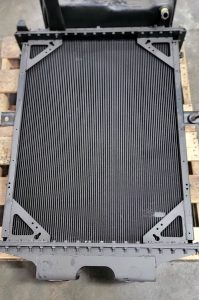
Class 8 vehicles are an essential component of the global supply chain. The efficient operation of these massive vehicles not only ensures the timely delivery of goods, but also significantly impacts the bottom line of transport companies and owner operators. One of the critical components that contribute to the smooth functioning of these vehicles is the radiator. Regular radiator maintenance will help prevent vehicle breakdowns, ensure optimal performance, and extend the engine’s lifespan.
Last week we had a unique situation in the shop that’s hard to put into words, but the picture says it all (on the left). This radiator had been neglected for so long that the fins, which help cool the engine, would fall off with just a light touch. Obviously, this radiator needed to be replaced. We’ve now installed a high-efficiency radiator in this truck. This new one (on the right) is much better than the original. It has 420 dimpled cooling tubes instead of the 320 in the stock version, and it features 19 fins per square inch, compared to the OEM’s 14-16 fins per square inch. These improvements mean it cools the engine more effectively, helping the vehicle run better, and last longer.
A radiator is a critical component of a vehicle’s cooling system. It helps regulate the engine’s temperature by transferring heat from the coolant fluid inside it to the air outside, thereby preventing the engine from overheating. The radiator consists of a series of thin tubes with fins that dissipate the heat, supported by fans that enhance the cooling. This continuous cycle of cooling the heated coolant and recirculating it back keeps the engine running at a safe operating temperature.
Proper radiator maintenance will prevent engine overheating. Class 8 vehicles are subjected to prolonged periods of operation and are often driven in very harsh conditions. Such factors can cause excessive heat generation within the engine compartment. Proper maintenance ensures that the radiator operates efficiently, dissipating the heat effectively, and preventing engine overheating, which can lead to catastrophic engine failures.
Taking care of your radiator will also optimize fuel efficiency, as an overheated engine will consume more fuel. By maintaining the radiator, you ensure that your truck’s engine runs at the optimal temperature, which in turn improves fuel efficiency. Given the volume of fuel heavy-duty trucks consume, even a minor improvement in efficiency can lead to substantial cost savings. Consistently managing the engine’s temperature also reduces wear and tear.
Regular maintenance of the radiator can significantly extend the lifespan of the engine, saving on costly repairs and replacements, and will reduce vehicle downtime. Fleet managers aim to maximize vehicle uptime. Radiator failures can lead to unexpected breakdowns, which can cause delays and increase operational costs. Routine radiator checks and maintenance can minimize these risks, ensuring that your vehicles remain road ready.
The consequences of neglecting your radiator can include engine overheating, coolant leaks, reduced performance, and financial impacts. When the radiator is not functioning correctly, the engine’s temperature can spike. Overheating can cause head gasket failures, leading to expensive repairs. In worst-case scenarios, it can cause the engine to seize, forcing a complete engine replacement. Radiators that are left unchecked can develop rust and corrosion, which can lead to coolant leaks, reducing the coolant levels, and compromising the system. An inefficient cooling system forces the engine to operate under duress, leading to decreased engine performance. The stress on the engine can cause diminished power output and adversely affect the overall driving experience. Apart from the direct repair costs associated with radiator and engine failures, there are indirect costs such as towing charges, lost business opportunities due to vehicle downtime, and potential penalties for delayed deliveries.
Following is “Best Practices” for radiator maintenance. Perform regular visual inspections of the radiator. Look for signs of leaks, rust, or corrosion. Inspect the hoses and connections for any signs of wear or damage. Regularly check the coolant level and quality. A drop in coolant levels can indicate a leak, while discolored coolant may suggest contamination. Use the correct type of coolant as specified by the vehicle manufacturer. Periodically flush the radiator to remove any accumulated debris, rust, or contaminants. This helps maintain the efficiency of the radiator and prevents blockages.
Other items to regularly check include performing a pressure test to identify any potential leaks or weaknesses in the radiator and cooling system (this can help preempt failures and address issues before they escalate), ensure the thermostat and cooling fans are functioning correctly (the thermostat regulates the coolant flow based on the engine temperature while the fans aid in dissipating heat), and schedule professional maintenance checks regularly. Trained mechanics can perform comprehensive inspections and address issues that may not be apparent during routine checks.
Keeping your radiator and cooling system running ship-shape will help ensure that your engine runs at its peak performance and efficiency level, does not overheat, lasts a long time, and keeps your rig rolling. Because if it isn’t rolling, it isn’t earning! To book an appointment for your truck, stop by our shop in Saxonburg, PA, call (724) 360-4080, or visit www.pittsburghpower.com.

